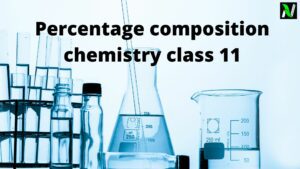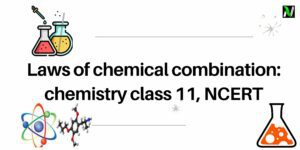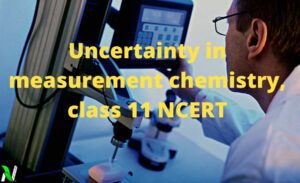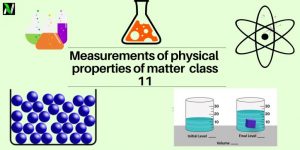In this article, we will discuss atomic mass & molecular mass in chemistry class 11. So let’s get started…
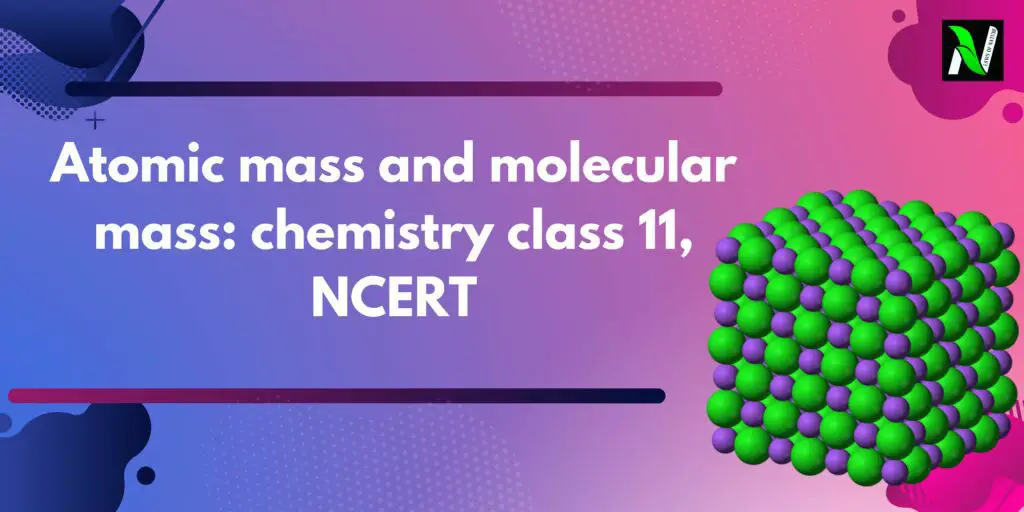
What is atomic mass?
The atomic mass or the mass of an atom is actually very-very small because atoms are extremely small. Nowadays we have sophisticated techniques, e.g., mass spectrometry to determine atomic masses fairly accurately. But in the 19th century scientists could determine the mass of one atom relative to another by experimental means. Hydrogen, the lightest atom, has been arbitrarily assigned a mass of 1 (unitless) and other elements have been assigned masses relative thereto.
However, the current system of atomic masses is based on carbon-12 as the standard agreed upon in 1961. Here carbon-12 is one of the carbon isotopes and can be represented as 12C. In this system is 12C assigned a mass of exactly 12 atomic mass units (amu), and the masses of all other atoms are given relative to this standard. An atomic mass unit is defined as a mass of exactly one-twelfth of the mass of a carbon-12 atom. And 1 amu $=1.66056 \times 10^{-24} \mathrm{~g}$.
Mass of an atom of hydrogen $ =1.6736 \times 10^{-24} \mathrm{~g} $ Thus, in terms of amu, the mass of hydrogen atom $\displaystyle{=\frac{1.6736 \times 10^{-24} \mathrm{~g}}{1.66056 \times 10^{-24} \mathrm{~g}}}$ $=1.0078\;\mathrm{amu}$ $=1.0080\; \mathrm{amu}$. Similarly, the mass of oxygen is $16\left({ }^{16} \mathrm{O}\right)$ atom would be $15.995$ amu. At recent, ‘amu’ has been replaced by ‘ $\mathbf{u}$ ‘, known as unified mass. When we use atomic masses of elements in calculations, we actually use average atomic masses of elements, which will be talked about in the below sections.
Atomic mass unit: It is defined as a mass of exactly one-twelfth of the mass of a carbon-12 atom.
Read Also
- Uncertainty in measurement chemistry, class 11 NCERT
- Laws of chemical combination: chemistry class 11, NCERT
What is Average Atomic Mass?
Many naturally occurring elements exist in more than one isotope. If we consider the existence of these isotopes and their relative abundance (percentage of occurrence), the average atomic mass of this element can be calculated. For example, carbon has the following three isotopes with relative abundances and masses as shown before each of them.
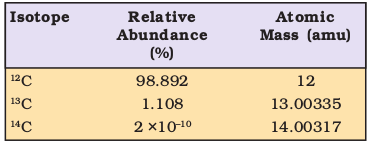
From the above data, the average atomic mass of carbon is:
| $\displaystyle(0.98892)(12u) + (0.01108)(13.00335u) +(2 \times 10^{-12}) (14.00317u) = 12.011u$. |
Similarly, the average atomic masses for other elements can be calculated. In the periodic table of elements, the atomic masses listed for different elements actually represent their average atomic masses.

Average Atomic Mass: The atomic mass of an element is the average mass of the atoms of an element measured in atomic mass units (amu, also known as Dalton, D).
Atomic mass is a weighted average of all isotopes of that element, multiplying the mass of each isotope by the abundance of that particular isotope. (Atomic mass is also known as atomic weight, but the term “mass” is more precise.
Read Also
- John dalton’s atomic theory: postulates & limitations, class 11, NCERT
- Importance of chemistry in our everyday life, class 11
What is Molecular Mass?
Molecular Mass: Molecular mass is the sum of the atomic masses of the elements present in a molecule.
It is obtained by multiplying the atomic mass of each element by the number of its atoms and adding them together. For example, the molecular mass of methane, which contains one carbon atom and four hydrogen atoms, can be obtained as follows: Molecular mass of methane, $$ \begin{aligned} &\left(\mathrm{CH}_{4}\right)=(12.011 \mathrm{u})+4(1.008 \mathrm{u}) \\ &=16.043 \mathrm{u} \end{aligned} $$ Similarly, molecular mass of water $\left(\mathrm{H}_{2} \mathrm{O}\right)$ $$\begin{aligned} &=2 \times \text { atomic mass of hydrogen }+1 \times \text { atomic } \\ &\text { mass of oxygen } \\ &=2(1.008 \mathrm{u})+16.00 \mathrm{u} \\ &=18.02 \mathrm{u} \end{aligned} $$
What is Formula Mass?
Some substances, such as sodium chloride, do not contain single molecules as their constituent units. In such compounds, positive (sodium ions) and negative (chloride ions) units are arranged in a three-dimensional structure as shown below.

Note that in sodium chloride, one Na+ ion is surrounded by six Cl− ions and vice versa. The formula, like NaCl, is used to calculate the formula mass and not the molecular mass. Mass as in the solid state, sodium chloride does not exist as a single entity. Therefore, the formula mass of sodium chloride is the atomic mass of sodium $+$ the atomic mass of chlorine. i.e, $=23.0.u+35.5u=58.5u$.
Formula mass: Formula mass is defined as the sum of the atomic masses of all the atoms in the formula unit in an ionic crystal.
| Question: Calculate the molecular mass of glucose $\left(\mathrm{C}_{6} \mathrm{H}_{12} \mathrm{O}_{6}\right)$ molecule. Solution Molecular mass of glucose $\left(\mathrm{C}_{6} \mathrm{H}_{12} \mathrm{O}_{6}\right)$ $=6(12.011 \mathrm{u})+12(1.008 \mathrm{u})+$ $6(16.00 \mathrm{u})$ $=(72.066 \mathrm{u})+(12.096 \mathrm{u})+ (96.00 \mathrm{u})$ $=180.162 \mathrm{u}$ |
Frequently Asked Questions – FAQs
What is the difference between atomic mass and molecular mass?
The atomic mass is the measure of the mass of an element, while the molecular mass is the calculation of the mass of a chemical compound.
What is the relationship between molecular mass and atomic mass?
The mass of a molecule is measured by its molecular mass, also known as atomic mass. It is usually calculated by multiplying the mass of each atom by the number of atoms of the element present in the molecule. For example, two hydrogen atoms and one oxygen atom make water.
What is the simple definition of atomic mass?
It is the mass of the single chemical element. It involves the masses of the three sub-atomic particles, viz. protons, neutrons and electrons.
What is meant by formula mass?
The formula mass of a substance is defined as the sum of the atomic masses of constituent atoms in an ionic compound. This is generally used for ionic compounds which do not contain discrete molecules, but ions as their constituent units.
How do you find a molecular mass?
To find the molecular mass, add the atomic masses of all of the atoms in the molecule
Stay tuned with Laws Of Nature for more useful and interesting content.



